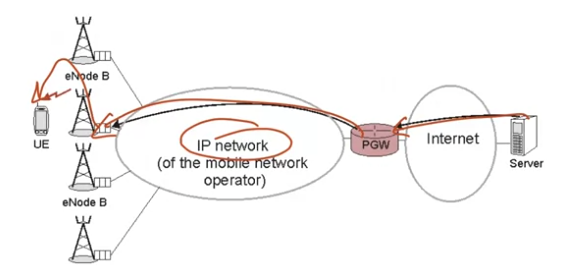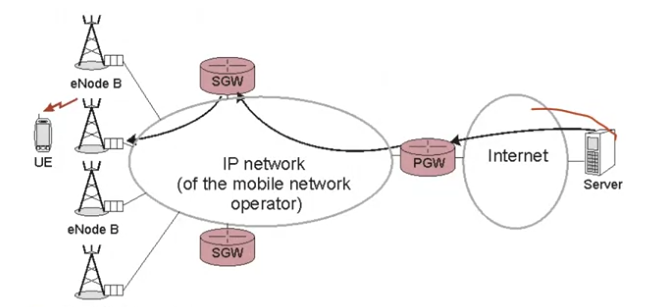The Packate Gateway (PGW)
- Routes data to the terminal
- Ensures certain security functions

The Internet network itself cannot manage mobility. Each packet is intended for an address and an address is generally linked to a physical location. The solution adopted for 4G networks, was to converge packets destined for mobile subscribers to a single network gateway called the PGW, or Packet Gateway. That means that when I consult a server, the packet – constituting, for example, a piece of a web site – will be transmitted through the Internet to my mobile operator’s P-Gateway, then from the P-Gateway to the base station using the mobile operator’s own IP network, and from the base station to my terminal over the radio channel. So, the function of the P-Gateway is to route data to the terminal and also to take care of a certain number of security functions. It is a gateway and it must be protected against attacks from outside.
The Region Gateway (SGW)

An SGW enables:
- collecting data sent by the mobile terminals through various eNB
- the distribution of data coming from servers to the eNB where the terminal is located
In the opposite direction, when I send a request from my smartphone, it’s the same thing. From the terminal to the eNode B, from the eNode B to the P-Gateway, from the P-Gateway to the server. If we have a network with a very large number of subscribers like in China, there can be several PGWs because one PGW does not have enough capacity to manage all packets. Several PGW can also be necessary to have redundancy and ensure reliability. However, P-Gateways are alimited in number. If you think about it for a second, the typical number of eNodeBs for a French network is around 10,000. In certain cases, in dense areas, the coverage of an eNodeB is just several hundred meters around that eNodeB. On the other hand, there are just a few P-Gateways, in 4G network.
If we consider the transfer to a terminal, when this terminal is moving, we can see we’ll have to notify the P-Gateway and route data NOT to the former eNodeB where the subscriber was before, but to the new eNodeB. This rerouting requires the exchange of signaling messages. To avoid frequent rerouting at the level of the P-Gateway, we’ll introduce intermediary equipment called the Serving Gateway.The Serving Gateway serves a given geographic zone, typically one French region.
Now, we have an additional hop: server- P-Gateway, P-Gateway - S-Gateway, S-Gateway -eNodeB. That seems slightly more complex, but the advantage is that, when the terminal moves, very often it remains under the same S-Gateway, and that it’s only the S-Gateway that has to manage this mobility, this rerouting. So, an S-Gateway enables not only the collection of data sent by the mobile terminals to various eNodeB, but also the distribution of data coming from servers to the eNodeBs where the terminal is, which is what we represented here. The Serving Gateway and the Packet Gateway are two very important elements of the core of the 4G network. Something to note is that the packets that make up the data stream – for example, the video stream I look at on my smartphone – go through the P-Gateway – it’s the entrance – and the Serving Gateway – which is linked to the place, the region where I am located.
Questions
- SWG means
- Serving GateWay
- An SGW:
- is a gateway that a geographical area and that forwards data packets sent to or from terminal
- A PGW:
- is a gateway that allows the 4G network and the internet to interconnect to each other
- When I use a 4G network (in a standard architecture), all the data packets sent to and from my terminal
- always go through a SGW an a PGW